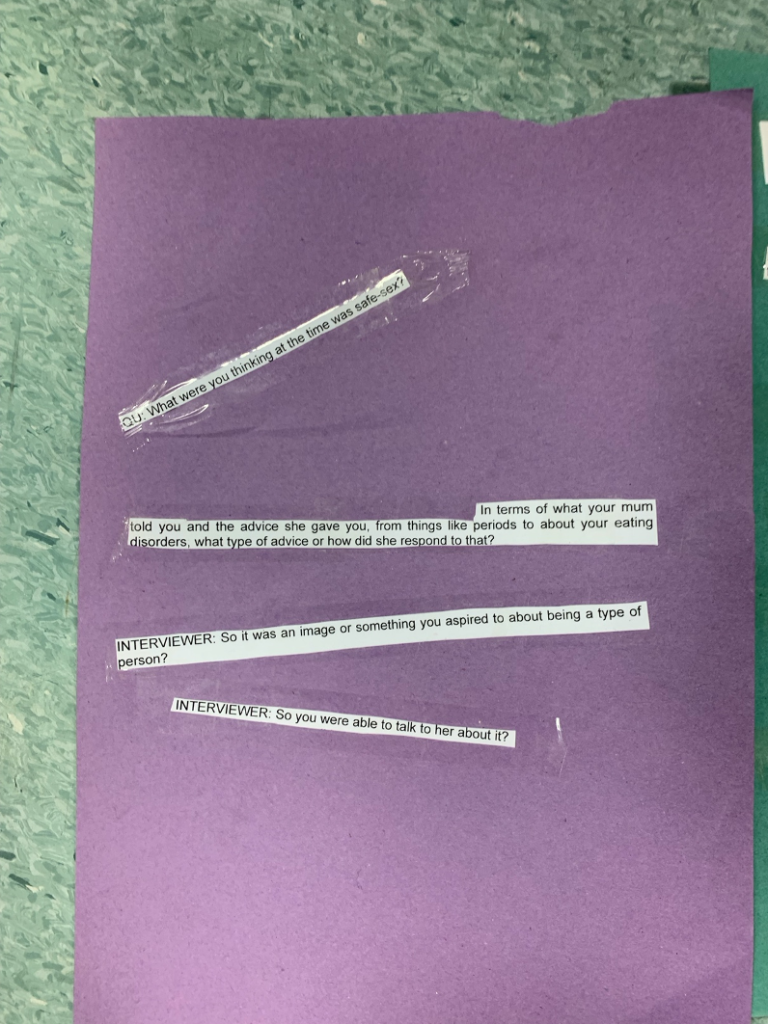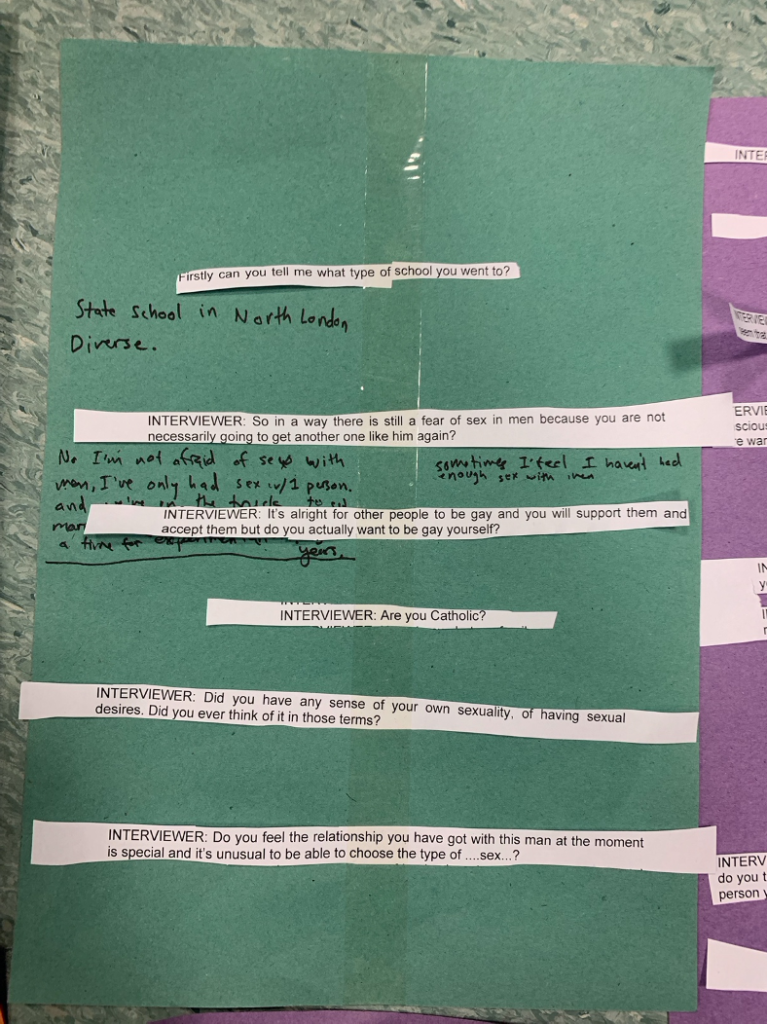Archive materials can be understood very broadly: newspapers, photographs, letters, official documents; diaries, personal memorabilia. There are a wealth of archives where such materials can be accessed and these can form part of the methods explored {list of sources. The focus for this method is on archived social research, especially qualitative data in the form of interviews, ethnographic notes, focus groups, visual methods. There are a wealth of sources for this material as well as guides for secondary analysis.
Introduction: what do we mean by Reanimating Data?
In this manual we share the key components of a method that was forged in our ESRC funded project. The project enabled us both to create an archive from a 30 year old study (the WRAP) and to use these archived materials as a starting point for new research with a new generation of young people. The Reanimating method that we share here can be used with any archived data sources, but to better understand the approach and examples shared in this module we suggest that you watch a short explainer which introduces you to the archived Women, Risk and AIDS project and to the Reanimating Data approach.

Henry Robinson, Public domain, via Wikimedia Commons
The idea of reanimating data is linked to a number of key methodological developments – an archival turn in the social sciences where we are engaging in secondary analysis of archived sources; a turn towards creative methods and the co-production of meaning and an interest in time as a feature of research design, for example in helping us understand continuity and social change. In this blog we have done the work of locating the methodology within a wider literature. We encourage you to read this as part of the manual. Here we summarise the key points:
What? Re-animation as a term which captures the liveness of the original data and the possibilities of making this available to new audiences in new contexts to be animated in new ways.
Why? The archive as a shared boundary object with the potential for critical pedagogy. Time-binds are a way of connecting past-present-future and feeling history.
Who for? Working with an intergenerational tradition/community – feminist activist research. Playful approaches to working with data with wide range of contemporary audiences.
Making sure the method is safe.
You will probably be exploring this method on your own. However the method is ideally suited to collaborative and group work and it is important to think about how we can make safe spaces to work in. Moreover, the materials and examples we are using in this manual focus on a sensitive area, young people’s intimate relationships which can include non-consensual sexual experiences. So before we start we need you to be prepared for working with these materials and to think about what you might need to do when working with others using these kinds of approaches. Generally we work with a group to brainstorm ground rules before we start this kind of work. These are some we developed when delivering this training to a group.
- Listen, support and encourage each other
- Share the airwaves.
- Everyone has the right to pass and to choose not to participate.
- Only share data that you have permission to share both in the workshop and afterwards.
Time for a quick break, before we go on explore the 4 methodological strategies that together constitute the Reanimating Data approach.
Strategy 1: Reasking
One productive way into an archive can be through the questions asked (rather than the answers provided). Focusing on questions can tell us a great deal about how issues or problems were framed by researchers in other times and places. They can also prompt us to answer the questions posed for ourselves – giving us a way of connecting present and past.
A key motif of the Reanimating Data approach is playfulness. Facing pages and pages of transcribed materials can be overwhelming. Treating the archive playfully and focusing on questions is one way of making these material accessible to new audiences. Here you can see how Ester McGeeney sets us the task of working with archived interview data when working with a group of young women (The Women’s Theatre Society) at the University of Manchester. She throws the pages into the air and asks them to find questions that resonate with them.
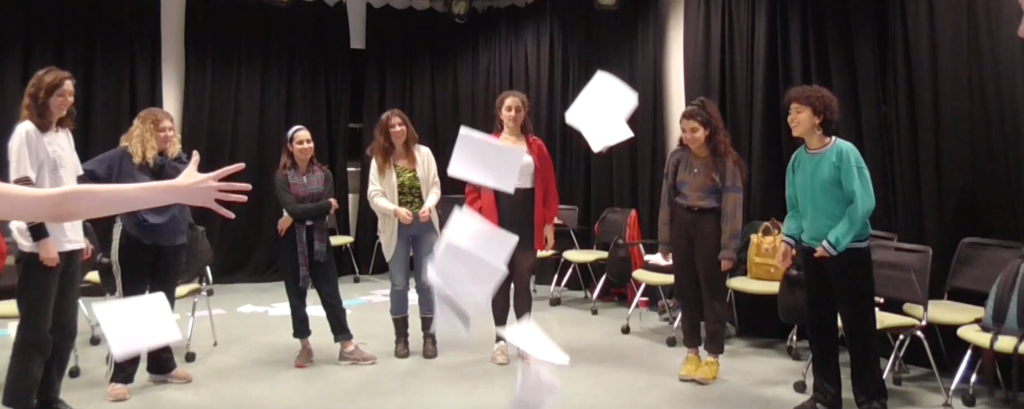
Once chosen, the participants engaged with the questions as a starting point for discussion and creative exploration. In these two short films you can see how this group of young women questioned the approach of the original research, but also answered the questions anew from their own perspectives.
We can try this our ourselves –
This is a question taken from one of the WRAP interviews (LJH22)
Mm. When you were talking about the sort of physical closeness, I was wondering whether – I mean when you think of sex what do you think of,
what – what does sex mean to you?
Spend 2 minutes free writing your answer or reaction to the question.
The method also works well as a focus group activity. So first the group are invited to play with the data and cut our a question or two. Then sitting in a circle individuals are asked in turn to pose the question they had chosen to the person sitting on their left. Here we see Ester asking a question to Jo that she has extracted from the data and Jo answers as best she can.
Ester: [to Jo] Okay, right, but I mean, how about the idea…I mean, do you see yourself as a Christian and living by those rules or anything?
Jo: Wow, how interesting. No, but of course I did when I was young and suddenly all of this is really making her come back. No, I don’t and I think that in fact recently I did a thing where I sort of wrote out, I tried to remember a lot of the attitudes that were put into my head about what sex was and what it was for and what it was not for, and whether it was spoken or not, what was approved of or gained of through facial expressions, or what got switched on or off on the telly or all of those things. And a lot of it was kind of expressions of female sexuality that was joyous got switched off or turned down or, you know, disapproved of, and I feel like a lot of those things went into my bones as a young person…..And so I wrote out my own stuff now which was more about sex being about joy and about connection and about generosity of spirit between people. And being yours, you know, and not for someone else to tell you what it could be. So I’m going to say no, I don’t, thank you. (laughs)
So as a method, reasking questions from archived materials can be a generative method that
- Provides prompts for focus group discussion and / or creative work.
- A playful method.
- Decentres the researcher.
- Facilitates intergenerational conversations and reflections on social change.
- Can give permission to explore less talked about areas.
- A method that requires a safe and supportive environment.
Strategy 2: Collaging
A second approach to reanimating data is collaging. This involves working with data alongside other relevant archival sources as raw materials for creative work – including the creation of posters, fanzines and poems.
Data poems:
This is a methods that can be done face to face or online. Participants are given interview material and asked to take scissors to it and chop it up. They then arrange phrases on a page in order to create their own poem. When we did this activity in person we would bring along photocopied visual materials from others archives (for example magazines, adverts and ephemera from 1988-9) and these could form part of the creative work. The poems would then be a focus for conversation and discussion, with participants talking both about their responses to the source material and the story that they were telling for themselves.
We were also able to do a version of this method virtually using the black-out poetry maker tool https://blackoutpoetry.glitch.me/
Participants copy and paste an extract of data into the tool and then highlight words and phrases that resonate for them. The tool blocks out the rest of the words revealing a poem that can then be the starting point for discussion. This poem was created using an extract from a WRAP interview about tradition and gendered aspirations:
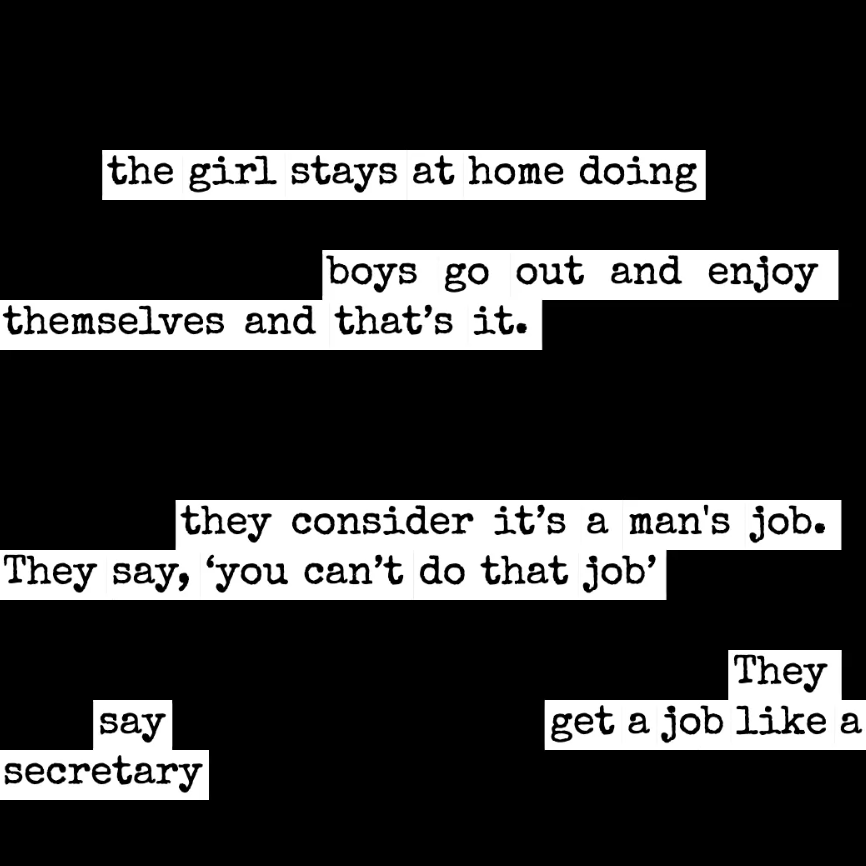
In the Reanimating data project participants often created collages juxtaposing 1989 and 2019, using a range of source materials. Again this creative work could then be the starting point for group discussion.
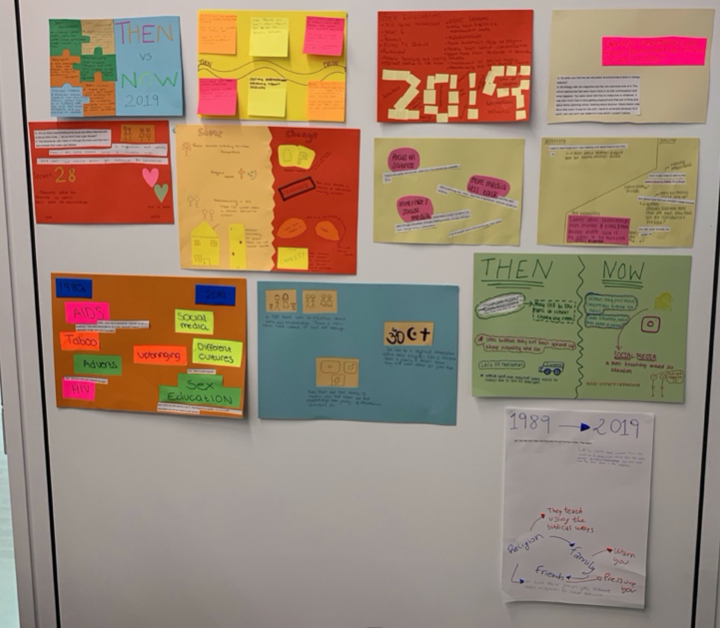
To find out more about how the Reanimating Data team worked with material from other archives you can read this blog written by Rachel Thomson. We also have a wealth of material linked to our work stored on a padlet for you to explore and to add to.
Strategy 3: Revoicing
The third method involves re-voicing the material, focusing on the answers rather than the questions. Inviting new participants to re-voice the words of others can be an interesting way of engaging them with the material and asking them to join you in collaborative analysis.
Choosing and then re-voicing the words of someone else can be a safe way of exploring issues. As we have seen it is possible to invite participants to experiment with how the material is performed, for example a story can be told as if it is a funny account. But is could also be told again in a very serious way. In order to experience this for yourself we invite you to work with the following data extract.
I went to an all girl’s school and my mum said’ ‘you do what you want’.
Interview with Leigh ss101
She didn’t say ‘well I think you should do this, and I think you should do that and I don’t want you to go to University because I think you will grow up and away from me’, and all this lot like one girl at college is having. Her mother is frightened that her daughter is going to grow up, whereas my Mum
said, ‘I wish you all the luck in the world’, because she didn’t achieve, so she’s not going to hold me back. She doesn’t force me to do anything I don’t want to do.
Try out delivering these lines in the following ways:
- as if you were telling a joke
- as if you were angry
- as if you were saying it to someone you are very close to
- as if you were a news broadcaster.
It may be that you get a sense that by exploring it in this way you are able to get deeper into the material, findings different kinds of meaning. This was the case when Ester worked with a group of young peer educators to reanimate her PhD research on young people’s accounts of good sex. Here you can see Carlos struggling to perform the words of interviewee Oscar.
The revoicing method allows research participants a safe way of telling their story through telling the story of someone else. In this short animation you can see how Emma reanimates an account that she found in the archive, a story that she is able to identify with.
Here Emma explains why she chose the extract that she did:
E: The first thing that interested me was the extract from the 80s with the women. And just like reading that and just seeing how like life is really similar to how it is now. I think that beforehand, I never really thought about it, but I think I thought it was different times obviously, I thought maybe that girls my age would have acted differently maybe and would have abided with the rules that they. Reading the extracts it was really similar, some girls were rebelling, like not getting on with their parents and all of that and that is still happening now. And I think that’s the thing that interested me.And what she got out of of reanimating the story:
E: The way she spoke. It felt really modern, like the way that people speak now. And I found out that the girl was actually black girl. Yeah I think I was told, after reading it, that she was black after reading it. In my mind I was thinking ‘oh all the girls that were interviewed were like white, white British’. It didn’t cross my mind that they could be asian, black or other races. I think that’s why I chose that extract.
R: Is it possible to say why it’s important to you to choose a black girl?
E: I felt like…It’s like representing. Representation really matters. It’s like seeing myself, in every area of life. Seeing a person who looks like you, like coming from your background, is really important. Like having role models as well….And I didn’t realise that Manchester at that time was really diverse as well. I thought only recently maybe that people came from different countries. I really thought that it was just like white people.. it’s good to hear that [there have] always been a diverse communities in Manchester for a really long time and people grew up – like that other races – black people, asian people – they grew up and were born in Manchester from a long time ago and they created their own families. It’s nice to hear that.
So as a method revoicing
- Creates opportunities for participants to analyse, interpret and comment on the data as a co-researcher.
- Acts as an invitation to participants to tell new stories but without any pressure to do so.
- Can provide participants with a sense of connection, solidarity and sense-making.
- Decentres the researcher and can allow participants to lead the research agenda.
To find out more see our further reading list.
Strategy 4: Recollecting
The final method that we cover here is ‘recollecting’ – the idea that participants exposed to archived materials may be inspired to tell their own stories and to contribute their own material and that of others to archives in the making.
The invitation to contribute to an archive for the future could be something very simple and accessible. So for example, when sharing the WRAP materials we invited participants at to contribute their own stories and experiences anonymously to the archive –filling a pinata with messages for others, creating patchwork squares for a banner, and uploading feminist objects into the digital archive

Banner created by RAD participants and friends at our International Women’s Day event in Manchester
The most sustained example of re-collecting emerged from the Women’s Theatre project where the participants took inspiration from the stories in the archives, and through a creative process of workshopping, they created a performance in which they wove their own stories with those of the archive. Here you can see a student who you heard re-voicing material in the previous section, using these insights and experience to generate her own feminist analysis of sexuality and social change. [go to scene 12 mins in]
So what do we learn from Recollecting?
- Gives participants permission and confidence to tell their own stories or to research the stories of others.
- New stories emerge in conversation with old stories.
- Participants contribute towards a collective storytelling project.
- Can use a range of expressive art forms (including non-verbal)
If you would like to contribute something to the FAYS archive as a result of the work you have done while finding out about this method (be it a collage, a poem, a photograph of a feminist object), you can use the upload tool to contribute to
our research and the lessons you learn. https://reanimatingdata.co.uk
So finally…..
we leave you with some key questions to consider for yourself in exploring this method and considering if and how you might use it.
- What source materials can you access
- What could create meaningful time-binds for your work, connecting ‘data’ with ‘audiences’?
- How might the different stakeholders think and feel about the ‘archive’? Boundary objects can be different things to different people.
- Making safe spaces for the work. What does ’care-full risk’ involve?
- What is the data? What/ whose is the analysis?
The Reanimating Data project involved a team of researchers: Ester McGeeney, Niamh Moore, Sharon Webb, Rosie Gahnstrom and Rachel Thomson. It was funded by the ESRC https://gtr.ukri.org/projects?ref=ES%2FR009538%2F1
Please cite the research when using the method.

